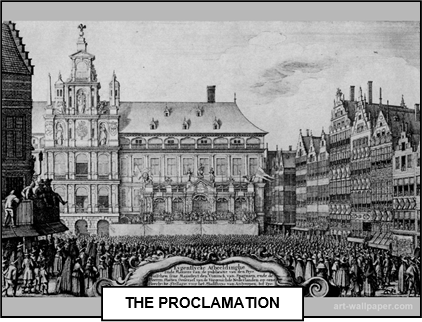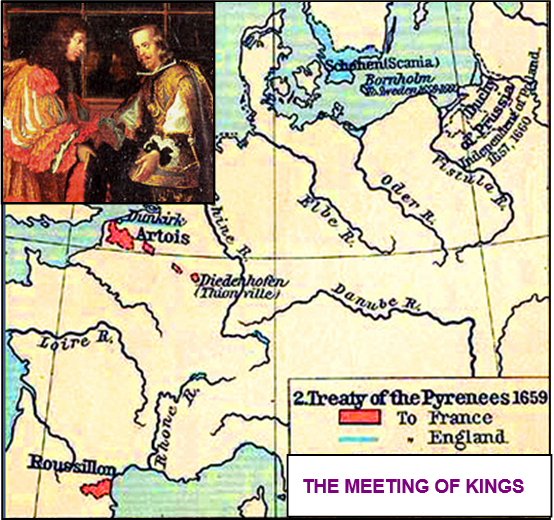


xxxxxThe Thirty Years’ War ended in 1648 (C1), but the war between France and Spain continued on for more than a decade. France had emerged from the war as a major power and wanted to stay that way. The French minister, Mazarin, even joined forces with Cromwell’s Commonwealth in 1657, and together they defeated the Spanish at the Battle of the Dunes the following year. For Spain, already in decline as a nation, the final blow came in August 1658 when a French alliance with a number of German states ended any hope of help from the Habsburgs. At the Treaty of the Pyrenees in 1659 Spain gave up all her land north of this mountain range, which then became the accepted boundary with her neighbour, France. In addition, a marriage was arranged between Marie Theresa, daughter of the Spanish king, Philip IV, and Louis XIV, a union which, as we shall see, was to have serious political repercussions in 1702 (AN).
THE TREATY OF THE PYRENEES 1659 (CW)
Acknowledgements
Proclamation:
engraving by the Bohemian etcher Wenceslaus Hollar (1607-
 xxxxxAs we have seen, it was in 1635
(C1) that the French (led by Cardinal Richelieu) entered
the Thirty Years' War. So deeply concerned were they about the
growing might of the Habsburg dynasty -
xxxxxAs we have seen, it was in 1635
(C1) that the French (led by Cardinal Richelieu) entered
the Thirty Years' War. So deeply concerned were they about the
growing might of the Habsburg dynasty -
xxxxxFor Spain it
was quite a different story. For some time the country had been in
political and economic decline. During the reign of the weak
Philip IV (1621-

xxxxxBut the end of the Thirty Years' War did not settle matters between the French and the Spanish, far from it. The independence of the Dutch Republic had actually been recognized by Philip IV in January 1648, before the Peace of Westphalia, and by this settlement Spain had agreed to a comprehensive trade agreement between the two countries. On the strength of this understanding, Spain refused to agree to the general peace treaty. As one might imagine, this alarmed Jules Mazarin, the French leader (illustrated). He could see a situation in which Spanish forces could be openly deployed in the Low Countries, posing a serious threat to the security of northern France. He maintained the war with Spain and, at the same time, renewed a military offensive along the French frontier with Germany, taking new territory in order to prevent the Spanish from receiving any aid from the Austrian Habsburgs.
xxxxxThe Franco-
 xxxxxThe Treaty of the Pyrenees
took place between Louis XIV of France and Philip IV of Spain in
November 1659 on a
neutral island in the River Bidassoa, near Hendaye in France
(illustrated). Spain ceded the province of Roussillon, thus making the
Pyrenees the boundary between the two countries, and, in the
north, relinquished the region of Artois and parts of Hainault, Flanders and Luxembourg. The
French acquisition of Alsace and Lorraine from the Holy Roman
Empire, negotiated at the Peace of Westphalia, was also ratified,
and all land conquered by the French in Catalonia was restored to
Spain.
xxxxxThe Treaty of the Pyrenees
took place between Louis XIV of France and Philip IV of Spain in
November 1659 on a
neutral island in the River Bidassoa, near Hendaye in France
(illustrated). Spain ceded the province of Roussillon, thus making the
Pyrenees the boundary between the two countries, and, in the
north, relinquished the region of Artois and parts of Hainault, Flanders and Luxembourg. The
French acquisition of Alsace and Lorraine from the Holy Roman
Empire, negotiated at the Peace of Westphalia, was also ratified,
and all land conquered by the French in Catalonia was restored to
Spain.
xxxxxLast but by no means least, the terms of the treaty also agreed to the marriage of Marie Theresa, daughter of Philip IV, to Louis XIV. The marriage took place the following year. By its terms, the Infanta renounced all her rights to the Spanish crown or Spanish possessions but, as we shall see, this proviso was conveniently ignored by the Sun King when it suited his purpose, and this was to lead to the War of the Spanish Succession in 1702 (AN). In the meantime, this marriage compact in particular, and the Treaty of the Pyrenees in general, were a triumph for the French statesman Jules Mazarin. By it France was to become the most powerful monarchy in Europe.
xxxxxIncidentally, at the Battle of the Dunes, English forces fought on
both sides. A contingent of English royalists commanded by the
Duke of York (later James II) fought on the Spanish side against a
Commonwealth infantry force. Following the Anglo-
CW-


